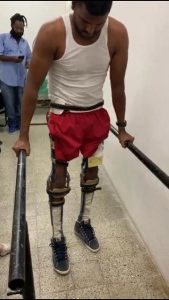Wheelchair-assisted Isurdeen walks again
UTTAMKUMAR Isurdeen, 34, a father of one, has been living with a disability after he was involved in a vehicular accident in 2010. He suffered tremendous damage to his spinal cord, and has been using a wheelchair ever since to assist with mobility.
But of late, things have been changing for the better for him. On Friday, Isurdeen confidently testified that he took his first step in nine years.
This was after an intervention was made, through the collaboration of the Ministry of Public Health with the PAHO/WHO and ProsthetiKa, an international agency on a mission to restore mobility to persons without it.
Collaborators started work at the Ptolemy Reid Rehabilitation Centre to provide orthotics by utilising multi-disciplinary measures to address spinal injuries and abnormalities.
A prosthetic brace was made to support Isurdeen’s hips, knees, ankles and feet to assist with relative movement. He remarked that the intervention has changed his life, “and it is only the beginning”.
Isurdeen recalled the accident when he was in the front passenger seat of a minibus, which was being driven at a reckless rate, causing the vehicle to flip several times, seriously injuring the passengers onboard.
“Since then, up until now, I thought it was a huge setback. However, I didn’t think about giving up, despite there was no advanced technology which would help me to walk again. But, today is the day, after nine years, I took my first set of steps. It was a breakthrough for me to get a brace, to stand up,” he said.

Jon Batzdorff, President of ProsthetiKa, said, “We made this HKAFO (hip, knee, ankle and foot orthosis), and it was a big job; everybody worked on this job. So he put it on and was ready to try it; to stand up independently. He stood and waved; that was another victory.”
According to Batzdorff, the project changes people’s lives, and ProsthetiKa is happy to have given Isurdeen the opportunity to be mobile again. This service offered by ProsthetiKa is provided free of charge to beneficiaries, as these braces could amount to hundreds of thousands of Guyana dollars.
Batzdorff said he never expected Isurdeen to be walking on the very first day after trying the brace, and that minor adjustments will have to be made to allow him to walk more ably with support from the orthosis.
Isurdeen said he is soon to begin a new job in an administrative capacity, and is quite excited to be working again, since the orthosis will play a major role in his new job. He shared that while using the wheelchair to get around, he kept himself active by being heavily involved in sports, particularly in 5k and 10k races that are hosted around the country, along with other athletic activities.
Isurdeen said his wife and his nine-year-old son remain his source of support and motivation.
“I want others who might have been injured to be able to join this programme and be more improved than I am,” Isurdeen said. (DPI)

